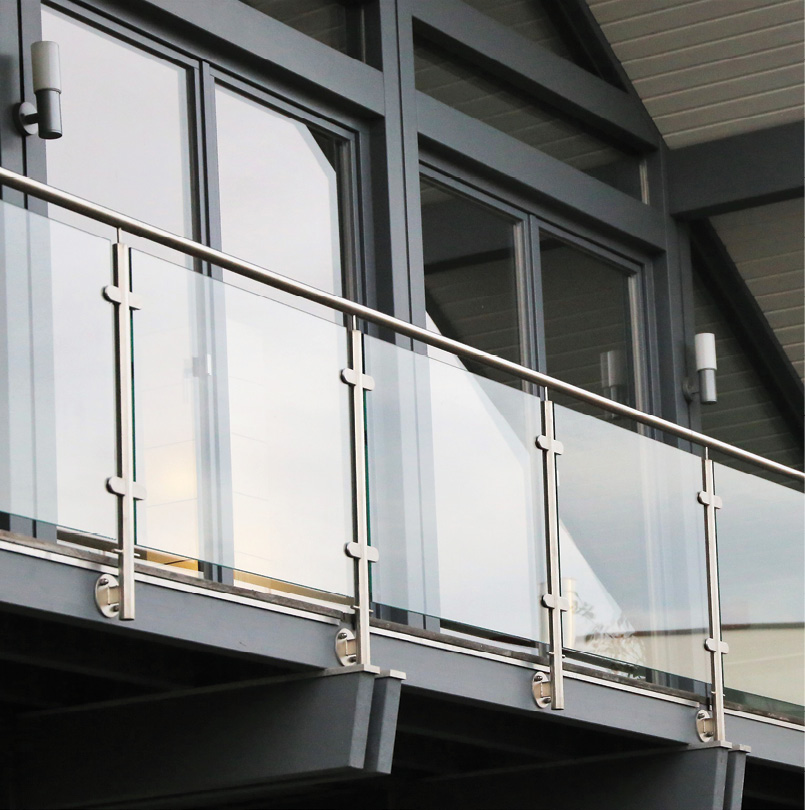Code Q&A | Glass railings & guards
Understanding the requirements for glass railings and guards

The requirements for glass railings and guards have evolved over the past several building code cycles, and the 2021 International Building Code further clarifies the requirements with defined terms. Use the following FAQ to navigate the changing requirements as states and local jurisdictions adopt new versions of the model code.
The technical services team at the National Glass Association has compiled answers to tough technical codes and standards questions in an easy-to-use, online help center. The Help Center is a resource included with membership.
Learn more about resources included with NGA membership
FAQs for glass railings and guards
How does the building code define railings and glass guards?
While the term “railing” is used throughout the code, it is not defined in the building code. Instead, the IBC defines the term “guard.” A guard is defined in Section 202 as a building component or system of building components located at or near the open sides of elevated walking surfaces that minimizes the possibility of a fall from the walking surface to a lower level. ASTM E2353 Standard Test Methods for Performance of Glass in Permanent Glass Railing Systems, Guards & Balustrades defines guardrail similarly.
Other related terms to understand and differentiate include:
- Handrail, defined in Section 202 of the IBC as a horizontal or sloping rail intended for grasping by the hand for guidance or support (2018/2021 IBC 2407).
- Baluster, while not specifically defined in the code, is typically understood to be a structural or load-bearing vertical panel in a guard system, such as a lite of glass.
- Infill panel, likewise, is not defined in the IBC, but is typically understood to be a non-load-bearing panel of material, such as a lite of glass, that occupies the space between supporting structural members of a guard system.
Do glass guards have to be laminated? If so, are there any exceptions to that rule?
Starting in the 2015 code, all glass used in guards and handrails must be:
- Laminated
- Either fully tempered or heat-strengthened
- Able to meet the safety glazing requirements of either Cat. I (16 C.F.R. 1201) or Class A (ANSI Z97.1).
In addition to protecting people from falling from one level to a lower level in a building, the code also intends to protect occupants from the potential risk of broken glass falling from guards located above walking surfaces. Accordingly, Section 2406.4.4 makes it clear that all glazing used in guards, “regardless of area or height above a walking surface shall be considered to be a hazardous location.” While this provision alone would permit the use of any approved “safety glazing,” Section 2407 imposes additional restrictions on the use of glass guards, thus requiring laminated and either fully tempered or heat-strengthened safety glazing.
The only exception to this requirement is where there is either no walking surface below them or any walkway below is permanently protected from the risk of falling glass. Where this exception applies, guards may use fully-tempered, non-laminated glass if it meets the safety glazing requirements of Cat. II (16 C.F.R. 1201) or Class A (ANSI Z97.1)
In all cases, the glass used in guards must have a minimum thickness of ¼ inch.
When is a top rail required?
A top, or cap, rail is required for glass baluster panels. In these type of guards, the glass is structural or load-bearing. The code requires these types of installations to include a top rail which must be attached to at least three glass balusters. This is intended to ensure that, should one of the glass baluster panels fail, the top rail will remain in place across the resulting opening.
Only one exception to this requirement exists: if the glass baluster is laminated and has been tested to remain in place as a barrier after impact or breakage in accordance with ASTM 2353, then a cap or top rail is not required. Refer to NGA Use of Laminated Glass in Glass Railing Systems for more details. For versions of IBC prior to 2018, the building code official was required to issue a variance to permit a glass baluster without a top rail.
Note, top rails are not required for infill panels, where the glass is in a non-load-bearing position supported by fixed structural metal posts or rails.
Why can’t tempered glass be used for glass guards? Is laminated glass stronger than tempered glass?
When applied to glass guards, the “strength” of glass can’t easily be defined solely based on whether it is laminated or tempered. In glass guard applications, a number factors must be considered when selecting the proper type of glass to be used. First, it is important to consider whether the glass will break safely if a break results from human impact. This alone might point to the use of either tempered or laminated glass. However, it is also important to consider the extent to which the glass will resist breakage in the first place, since breaking through a glass guard assembly could result in a serious fall from one level of a building to another. This consideration would likely point to the use of a fully tempered glass.
Finally, however, it is also important to consider the extent to which the glass itself will resist falling out of the guard assembly when impacted or broken, since glass falling onto a walkway below could also hurt someone. Given all of these considerations (with the one limited exception discussed above), the code requires all glass used in guards and handrails to be (i) laminated, and (ii) either fully tempered or heat strengthened, and (iii) to meet the safety glazing requirements of either Cat. I (16 C.F.R. 1201) or Class A (ANSI Z97.1). Refer to the NGA Laminated Glazing Reference Manual for more details on laminated glass strength.
What test standards are required to prove the glass is suitable for glass guards?
To qualify as safety glazing, the glass must be tested to and meet the acceptance criteria, including impact tests, of Consumer Product Safety Commission 16 CFR Part 1201 Safety Standard for Architectural Glazing Materials or ANSI Z97.1 Standard Safety Glazing Materials Used in Buildings - Safety Performance Specifications and Methods of Test. The glass supplier is responsible for testing and labeling the product.
Glass railing system testing is done according to ASTM E2353 Standard Test Methods for Performance of Glass in Permanent Glass Railing Systems, Guards & Balustrades. The standard evaluates static strength, impact resistance, and post-break retention. Railing systems are specified according to ASTM E2358 Standard Specification for the Performance of Glass in Permanent Glass Railing Systems, Guards, and Balustrades.
What labeling is required for laminated glass used in railings and guards?
The building code requires glass in guards be permanently marked as safety glazing with the manufacturer’s mark, including type and thickness of glass, manufacturer or installer name and the safety glazing standard. For laminated glass, the building code official may approve a certificate or other evidence in lieu of a permanent label (refer to 2018/2021 IBC Section 2403.1 Identification and Section 2406.3 Identification of safety glazing). NGA Glass Technical Paper FB11-06 (2020) Marking and Labeling of Architectural Laminated Glass explains the requirements in more detail.
How do I calculate the design load, including the factor of safety, for glass guards?
Glass guards must be designed to meet two separate load requirements: a linear load of 50 pounds per linear foot and a concentrated load of 200 pounds (2018/2021 IBC Section 1607.8). In addition, glass used in guards must be designed using a factor of safety of four (2018/2021 IBC Section 2407.1.1). Compliance with this safety factor can be determined by dividing the traditional glass strength values by four. Glass strength values are published for the glass industry in NGA Glass Technical Paper FM05-12 Physical and Mechanical Properties of Typical Soda Lime Float Glass.
The safety factor of four applies only to the glass, not to the other non-glass materials in the guard system, such as metal structural posts or rails.
What standards apply for a glass balcony guard in high-velocity hurricane zone regions such as in Miami?
In high windload areas, the building code intends to prevent exterior glass guards from becoming windborne debris missiles. 2018/2021 IBC Section 2404.1 Windloads in Vertical Glazing Applications requires laminated glass in guards. Additionally, if the top rail is attached to any other glass in the guard, the other glass must meet the windborne debris requirements in 2018/2021 IBC Section Windloads.
How wind interacts with the glass guard depends on the design, which could range from narrow glass columns to wide infill panels with high surface area. Wider panels could result in a large positive pressure pushing the glass toward the building and simultaneous negative loads pulling the glass toward the building. Consult with a qualified design professional for specific installations.


